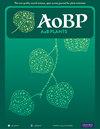镰刀菌枯萎病抑制了绿豆产量,原因是来源减少
IF 2.4
3区 生物学
Q2 ECOLOGY
引用次数: 0
摘要
绿豆 [Vigna radiata (L.) R. Wilczek var. radiata] 是消费者重要的植物蛋白来源,也是亚洲、澳大利亚和非洲种植者的高价值出口作物。然而,许多商业栽培品种极易受到生物胁迫的影响,从而在一季内迅速减产。Fusarium oxysporum 是一种土传病原体,是全球绿豆种植者日益关注的问题。这种病原体通过感染植物根系引起镰刀菌枯萎病,导致毁灭性减产。为了了解镰刀菌对绿豆生长发育和产量的影响,并确定耐受的基因型,研究人员对 23 个不同的品种进行了研究。2016 年和 2021 年,在澳大利亚昆士兰州沃里克市的雨水灌溉条件下进行了田间试验,调查了病害和无病害条件下的物候、冠层和产量成分性状的变化。分析表明,所有性状的遗传变异程度都很高。通过比较这些性状在两种环境下的表现,我们确定了在有病和无病条件下支撑产量的关键性状。在无病害条件下,50%开花期的地上生物量成分被确定为产量发展的重要驱动因素,而当受到镰刀菌影响时,产量减少高达96%。此外,还确定了 8 个耐镰刀菌的基因型。发现这些基因型表现出不同的表观和形态行为,从而证明了培育具有一系列不同性状变异的耐受性品系的潜力。在作物改良计划中,可以利用鉴定出的耐受性基因型来维持病害压力下的产量。本文章由计算机程序翻译,如有差异,请以英文原文为准。
Fusarium wilt constrains mungbean yield due to reduction in source availability
Mungbean [Vigna radiata (L.) R. Wilczek var. radiata] is an important source of plant protein for consumers and a high-value export crop for growers across Asia, Australia, and Africa. However, many commercial cultivars are highly vulnerable to biotic stresses, which rapidly reduces yield within the season. Fusarium oxysporum is a soil-borne pathogen that is a growing concern for mungbean growers globally. This pathogen causes Fusarium wilt by infecting the root system of the plant resulting in devastating yield reductions. To understand the impact of Fusarium on mungbean development and productivity and to identify tolerant genotypes, a panel of 23 diverse accessions were studied. Field trials conducted in 2016 and 2021 in Warwick, Queensland, Australia under rainfed conditions investigated the variation in phenology, canopy and yield component traits under disease and disease-free conditions. Analyses revealed a high degree of genetic variation for all traits. By comparing the performance of these traits across these two environments, we identified key traits that underpin yield under disease and disease-free conditions. Aboveground biomass components at 50% flowering were identified as significant drivers of yield development under disease-free conditions and when impacted by Fusarium resulted in up to 96% yield reduction. Additionally, eight genotypes were identified to be tolerant to Fusarium. These genotypes were found to display differing phenological and morphological behaviours, thereby demonstrating the potential to breed for tolerant lines with a range of diverse trait variations. The identification of tolerant genotypes that sustain yield under disease pressure may be exploited in crop improvement programs.
求助全文
通过发布文献求助,成功后即可免费获取论文全文。
去求助
来源期刊

AoB Plants
PLANT SCIENCES-
CiteScore
4.80
自引率
0.00%
发文量
54
审稿时长
20 weeks
期刊介绍:
AoB PLANTS is an open-access, online journal that has been publishing peer-reviewed articles since 2010, with an emphasis on all aspects of environmental and evolutionary plant biology. Published by Oxford University Press, this journal is dedicated to rapid publication of research articles, reviews, commentaries and short communications. The taxonomic scope of the journal spans the full gamut of vascular and non-vascular plants, as well as other taxa that impact these organisms. AoB PLANTS provides a fast-track pathway for publishing high-quality research in an open-access environment, where papers are available online to anyone, anywhere free of charge.
 求助内容:
求助内容: 应助结果提醒方式:
应助结果提醒方式:


